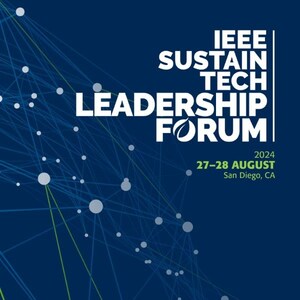LOS ALAMITOS, Calif., Dec. 16, 2021 /PRNewswire/ -- The IEEE Computer Society (IEEE CS) revealed the scorecard for its 2021 Technology Predictions, which measures the performance of trending technologies against the projections made in December 2020. The IEEE CS Technology Predictions for 2021 garnered a collective grade of B-.
The IEEE CS Technology Predictions for 2022 will be revealed in January – sign up for free exclusive access.
"Last year was as unpredictable as 2020, and not surprisingly our predictions were graded the same as in the previous year, averaging a B- score," said Dejan Milojicic, former IEEE CS president (2014) and current Distinguished Technologist at Hewlett Packard Labs. "The advancement of technologies requiring a remote workforce due to the pandemic was certainly accelerated, while most other technologies were not accelerated as much. We look forward to finalizing the 2022 predictions and tracking the paths of the most rapidly moving developments in the year ahead."
Remote workforce technologies (graded A) were strongly driven by the need for work continuity; they were critical for many industries and professions in which physical presence was not required. HPC as a Service (graded B+) enabled remote access to high-performance resources critical in pandemic evaluations. In-memory computing (graded B) was deemed to have made progress in the last year.
In addition to measuring the success in prediction, this year the team tracked technology maturity, their confidence, and the impact the technologies have made, presented in the "Scorecard of the Predictions" graph. All values for these four categories were assigned by averaging their individual grading per each technology predicted last year from A to F. For maturity, they were motivated by the technology readiness level which was adjusted for that purpose. They mapped A-F respectively as mature, emerging, incubating, prototype, conceptual, and unsuccessful. In the graph, bubble color corresponds to maturity level, bubble diameter corresponds to impact, and success in prediction and our confidence are represented on Y and X axes respectively. If some predictions are ranked the same alphabetic grade, numerically they may differ which is reflected in their ranking order. This is presented in the rank-ordered list that follows the graph. The team will continue to experiment with scorecards in the next year including simplifying summary graphs, introducing trending, and eliminating perceived correlation across metrics.
The 2021 technologies predicted last year are listed, rank-ordered by the success of the predictions. The current grade is included, followed by a comparison to how they were ranked last year.
1 |
Remote workforce technologies (graded A, same rank). In hindsight, it was obvious that remote technologies, such as collaborative tools and remote presence would be very successful. This is true in a variety of use cases, such as education, manufacturing, and healthcare, none of which were deemed easily conducted remotely before the pandemic. The team was very confident about this technology, the impact was high, and the technologies evolved to be more mature. This technology was exactly where it was predicted to be, ranking 1. |
2 |
HPC as a Service (graded B+, improved rank). The team predicted the delivery of High Performance Computing as a Service (HPCaaS) as it is increasingly embraced among HPC users. The convergence of AI, high performance data analytics, and HPC further fueled the growth and adoption of HPCaaS. Similar to remote workforce technologies, the confidence of the team was high, the impact was high and the technology reached maturity level. This technology overperformed compared to the prediction last year (rank 6). |
3 |
In-memory computing (B+, improved rank). Although in-memory computing is still not a mature technology, several emerging implementations reached beyond prototypes and have resulted in relatively high ranking, although with somewhat lower confidence. This is amplified by the potentially huge impact this technology could have on the market, in particular in edge and endpoint systems requiring low power. This technology significantly overperformed compared to the prediction last year (rank 10). |
4-5 |
Machine Learning (ML) for additive and subtractive manufacturing (B, improved rank) and advanced cyberweapons (B, improved rank) share positions 4-5, with exactly the same ranking. The advancements of both technologies were correctly predicted. The impact of ML for additive manufacturing is slightly amplified by the pandemic and need for remote work, but maturity is still lower than advanced weapons. Advanced cyberweapons were equally amplified by the pandemic and have unfortunately achieved a higher degree of maturity, as evidenced by a number of attributed or assumed cyberattacks that took place last year. (They were ranked 11 and 12 last year.) |
6 |
Social distancing technologies (B, decreased rank). While a much higher success of these technologies was expected, their impact is still high yet slightly tempered due to controversy associated with privacy regulations. Social distancing technologies did not advance as they might have done mostly because of concerns over (potential) privacy violation, not because of intrinsic technology shortcomings. All of this also resulted in lower confidence in the scoring. Last year these technologies were ranked at the same place as remote workforce (1), so these technologies significantly underperformed compared to what was predicted. |
7 |
Reliability/safety challenges for intelligent autonomous systems (B-, decreased rank). The team continues to believe in the importance of these technologies but expected a slightly higher rate of progress during the past year. Automation is one of the enablers in many other technologies, including remote workforce technologies and social distancing as discussed above, but it just may be that its time has not as yet arrived. Last year these technologies shared first place with remote workforce and social distancing, so they, too, significantly underperformed. |
8-9 |
Synthetic data for training ML systems free of bias (B/C, decreased rank) and disinformation detection (B/C, decreased rank) share positions 8-9 with exactly the same score. This is another pair of related technologies with a similar maturity level (incubating) and a similar level of impact. The overall confidence in evaluating disinformation detection was much higher than for synthetic data for bias-free ML training. Synthetic data for training ML systems free of bias was ranked 4 last year and disinformation detection fifth, hence they both underperformed. |
10 |
Low latency virtual musical rehearsal and performance (B/C, decreased rank). This is a relatively narrow market but a nice success story that enabled musical performances and rehearsals last year. There are already some early products on the market and new ones coming. Last year, this technology ranked 9. |
11 |
Trustworthy and explainable AI/ML (C+, decreased rank). These technologies continue to have huge importance, but unfortunately, little progress has been made during the past year, in the direction of trustworthiness and explainability, which are closely tied. New hardware and software approaches offer some potential but have not been realized. This technology has the least maturity. Last year, these technologies were ranked 8. |
12 |
Election security / social media controls (C, decreased rank). Similar to social distancing and disinformation detection, election security and social media controls were not successful this year. Another reason for the lack of progress is their close tie-in with governance, which is extremely complex to introduce. Also similar to the previous technologies, these have less maturity. Last year, these technologies were ranked 7. |
Following the established process from previous years, the authors who originally made the predictions in November 2020 evaluated their predictions individually. The averages and standard deviations were used as a basis for the discussion that eventually resulted in the final rating.
The 2021 Scorecard was prepared by Mary Baker (HP Inc.), Thomas Coughlin (Coughlin Associates), Paolo Faraboschi (Hewlett Packard Labs), Eitan Frachtenberg (Reed College), Hironori Kasahara (Waseda University), Kim Keeton (Google), Danny Lange (Unity Technologies), Phil Laplante (Penn State), Andrea Matwyshyn (Penn State Law), Avi Mendelson (Technion), Dejan Milojicic (Hewlett Packard Labs), Cecilia Metra (Bologna University), and Roberto Saracco (IEEE FDC).
Sign up to receive the 2022 Tech Predictions to be announced in January.
About the IEEE Computer Society
The IEEE Computer Society is the world's home for computer science, engineering, and technology. A global leader in providing access to computer science research, analysis, and information, the IEEE Computer Society offers a comprehensive array of unmatched products, services, and opportunities for individuals at all stages of their professional careers. Known as the premier organization that empowers the people who drive technology, the IEEE Computer Society offers international conferences, peer-reviewed publications, a unique digital library, and training programs. Visit computer.org for more information.
SOURCE IEEE Computer Society

WANT YOUR COMPANY'S NEWS FEATURED ON PRNEWSWIRE.COM?
Newsrooms &
Influencers
Digital Media
Outlets
Journalists
Opted In





Share this article